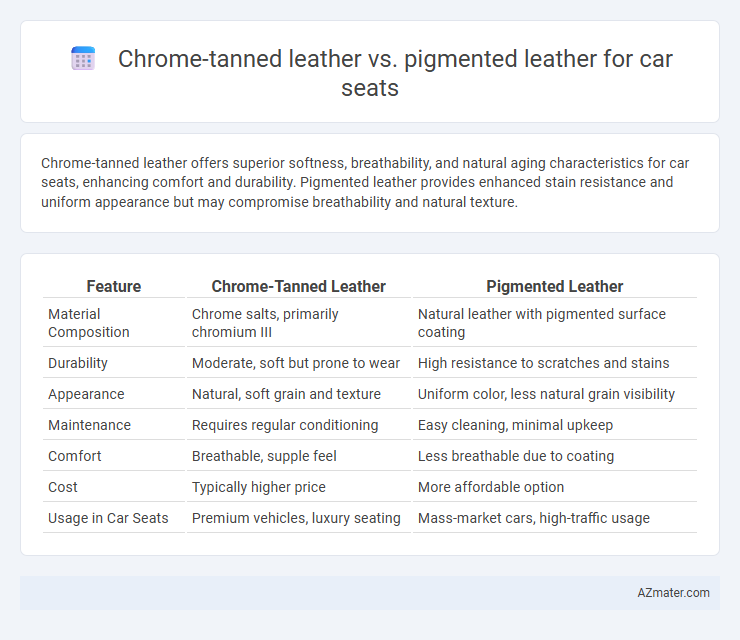Chrome-tanned leather offers superior softness, breathability, and natural aging characteristics for car seats, enhancing comfort and durability. Pigmented leather provides enhanced stain resistance and uniform appearance but may compromise breathability and natural texture.
Table of Comparison
| Feature | Chrome-Tanned Leather | Pigmented Leather |
|---|---|---|
| Material Composition | Chrome salts, primarily chromium III | Natural leather with pigmented surface coating |
| Durability | Moderate, soft but prone to wear | High resistance to scratches and stains |
| Appearance | Natural, soft grain and texture | Uniform color, less natural grain visibility |
| Maintenance | Requires regular conditioning | Easy cleaning, minimal upkeep |
| Comfort | Breathable, supple feel | Less breathable due to coating |
| Cost | Typically higher price | More affordable option |
| Usage in Car Seats | Premium vehicles, luxury seating | Mass-market cars, high-traffic usage |
Introduction to Car Seat Leather Types
Chrome-tanned leather in car seats offers superior softness, durability, and resistance to wear due to its chromium salt tanning process, making it a popular choice for luxury and comfort. Pigmented leather features a protective coating of colored pigments that enhances stain resistance and color consistency, often used in high-traffic areas requiring easy maintenance. Understanding these leather types helps consumers balance aesthetics, durability, and upkeep when selecting car seat materials.
What is Chrome-Tanned Leather?
Chrome-tanned leather is processed using chromium salts, which enhances its durability, softness, and resistance to water and heat, making it ideal for car seats that require long-lasting comfort and performance. This tanning method preserves the leather's natural texture and flexibility while providing improved color retention and resistance to wear compared to pigmented leather. Chrome-tanned leather offers a premium, breathable surface that ages gracefully, maintaining its luxurious feel over time in automotive interiors.
What is Pigmented Leather?
Pigmented leather for car seats refers to leather coated with a pigmented layer that enhances durability, color uniformity, and resistance to wear and UV damage. Unlike chrome-tanned leather, which retains the natural surface and softness of the hide, pigmented leather features a protective pigment finish that masks imperfections and requires less maintenance. This type of leather is commonly used in automotive interiors for its long-lasting appearance and easy-to-clean properties.
Durability Comparison: Chrome-Tanned vs Pigmented Leather
Chrome-tanned leather offers superior durability due to its flexible, soft texture combined with good resistance to wear and tear, making it ideal for car seats subjected to regular use. Pigmented leather features a durable surface coating that protects against scratches, stains, and UV damage, enhancing its lifespan but sometimes sacrificing breathability and softness. Overall, pigmented leather generally provides stronger protection against environmental factors, while chrome-tanned leather excels in comfort and natural aging, with both types offering varying advantages depending on usage conditions.
Comfort and Aesthetic Differences
Chrome-tanned leather offers superior softness and breathability, enhancing seat comfort by conforming more naturally to body contours and allowing better air circulation. Pigmented leather features a durable, uniform coating that resists stains and fading, providing a consistent matte or glossy finish that maintains aesthetic appeal over time. While chrome-tanned leather emphasizes a luxurious, supple feel with natural grain visibility, pigmented leather prioritizes ease of maintenance and long-lasting color vibrancy for car seat interiors.
Maintenance and Cleaning Requirements
Chrome-tanned leather offers easier maintenance and cleaning due to its natural surface that allows dirt and spills to be wiped off with a damp cloth, requiring only occasional conditioning to prevent dryness. Pigmented leather features a durable, synthetic coating that resists stains and UV damage, making it highly resistant to fading and easier to clean with mild soap and water. Both types benefit from regular gentle cleaning, but pigmented leather's protective finish reduces the frequency of intensive maintenance compared to chrome-tanned leather.
Cost Analysis of Chrome-Tanned and Pigmented Leather
Chrome-tanned leather generally incurs higher manufacturing costs due to its complex tanning process but offers superior softness and durability compared to pigmented leather. Pigmented leather, while more affordable and easier to maintain, involves fewer processing steps and can lead to quicker wear, impacting long-term replacement expenses. Evaluating total cost of ownership for car seats requires balancing upfront chrome-tanned leather prices against potential savings in longevity and comfort.
Environmental Impact and Sustainability
Chrome-tanned leather involves the use of chromium salts, which can pose significant environmental hazards due to toxic waste and water pollution if not managed properly. Pigmented leather, often coated with synthetic polymers, reduces natural leather's breathability but can incorporate eco-friendly finishes that lower chemical use and extend seat longevity. Sustainable car seat options increasingly favor vegetable-tanned or chrome-free processes, highlighting the environmental concerns associated with traditional chrome tanning and the potential for greener alternatives.
Common Applications in Car Interiors
Chrome-tanned leather is widely used in car seats for its softness, durability, and natural appearance, making it ideal for luxury and premium vehicle interiors. Pigmented leather features a protective coating that enhances resistance to stains, UV rays, and wear, commonly applied in family and fleet vehicles requiring easy maintenance and long-lasting durability. Both types are favored in automotive upholstery, with chrome-tanned leather focusing on comfort and elegance, while pigmented leather emphasizes practicality and robustness.
Choosing the Best Leather for Your Car Seats
Chrome-tanned leather offers superior softness, breathability, and a natural feel ideal for car seats, while pigmented leather provides enhanced durability, resistance to stains, and easier maintenance due to its protective coating. When choosing the best leather for your car seats, prioritize comfort and luxury with chrome-tanned leather or opt for pigmented leather if longevity and low upkeep are your main concerns. Evaluating factors such as climate, usage frequency, and aesthetic preferences will guide the optimal leather selection for automotive interiors.

Infographic: Chrome-tanned leather vs Pigmented leather for Car seat
 azmater.com
azmater.com